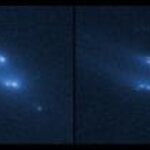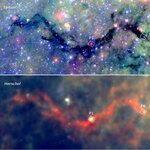Space

Calling H.P. Lovecraft: Galaxies in the vast empty regions of the Universe are actually aligned into tendrils.
A team of astronomers based at The University of Western Australia node of the International Centre for Radio Astronomy Research (ICRAR) has found short strings of faint galaxies in what were previously thought to be extremely empty parts of space. The Universe is full of vast collections of galaxies that are arranged into an intricate web of clusters and nodes connected by long strings. This remarkably organized structure is often called the 'cosmic web', with busy…

When astronauts get sick from zero g during long duration flights in zero g, the best medicine is to return them to Earth and full gravity. So, what if they could spend a few hours or minutes a day in artificial gravity during the flight?
It's far easier to do this if humans can tolerate fast spin rates, say as fast as 30 rpm, at least for a short while. Artificial gravity varies as the square of the spin rate, for instance, at 30 rpm you get full g in a centrifuge with a diameter of 2 meters- while at 3 rpm, you need a diameter of 200 meters (nearly three times the size of the ISS).
So far,…

Joseph Carroll's ingenious idea is to attach a tether from the crewed Soyuz spaceship to its final stage - and use this as a counterweight to do the first ever real experiment in tethered artificial gravity. He has found a way to do this without using a drop of extra fuel.
Both are in orbit already. When astronauts go to the ISS, the final stage of the Soyuz FG launcher (which still contains the crew at this point) first goes into a low altitude orbit between 200 and 242 kms in altitude . Then the Soyuz TMA with the astronauts o board separates, and accelerates up to the higher orbit of…

A vast belt of carbon monoxide located at the fringes of the Beta Pictoris system is concentrated in a single clump located about 8 billion miles from the star, or nearly three times the distance between the planet Neptune and our sun.
The total amount of CO observed exceeds 200 million billion tons, equivalent to about one-sixth the mass of Earth's oceans.
The presence of all this gas is interesting because ultraviolet starlight breaks up CO molecules in about 100 years, much faster than the main cloud can complete a single orbit around the star.
The researchers calculated that to offset…

The Hubble Space Telescope has captured a never-before-seen break-up of an asteroid, P/2013 R3, which has fragmented into as many as ten smaller pieces.
Although fragile comet nuclei have been seen to fall apart as they approach the Sun, nothing like the breakup of P/2013 R3 has ever been observed before in the asteroid belt.
The crumbling asteroid, designated P/2013 R3, was first noticed as an unusual, fuzzy-looking object on 15 September 2013 by the Catalina and Pan-STARRS sky surveys. Follow-up observations on 1 October with the Keck Telescope on Mauna Kea, Hawaii, revealed three co…

In a new Hubble telescope image, spiral galaxy ESO 137-001 is zooming toward the upper right, in between other galaxies in the Norma cluster located over 200 million light-years away.
The road is perilous: intergalactic gas in the Norma cluster is sparse, but so hot at 180 million degrees Fahrenheit that it glows in X-rays.
The spiral plows through the seething intra-cluster gas so rapidly, at nearly 4.5 million miles per hour, that much of its own gas is caught and torn away. Astronomers call this "ram pressure stripping." The galaxy's stars remain intact due to the binding force of their…

This continues from my earlier article "Ten reasons not to live on Mars, great place to Explore." Many of the ideas in that article apply not just to Mars but to the solar system generally.
I believe that the best attitude to the solar system is to go into space in a process of open ended exploration and discovery, with no end date. We can also go there to find solutions to problems on Earth itself. I firmly believe however that we shouldn't go into space hoping to make a fresh start and to escape disasters on the Earth.
This is just because it turns out we live in a solar system with no…

Astronomers studying nearby galaxy M83 have found a new super-powered small black hole, named MQ1.
M83, the iconic Southern-sky galaxy, is being mapped with the Hubble Space and Magellan telescopes (detecting visible light), the Chandra X-ray Observatory (detecting light in X-ray frequencies), the Australia Telescope Compact Array and the Very Large Array (detecting radio waves).
Astronomers have found a few compact objects that are as powerful as MQ1, but have not been able to work out the size of the black hole contained within them until now. The team observed the MQ1 system with…

How accurately can you simulate the universe's most violent events?
Enrico Ramirez-Ruiz wanted to find out, so when the first detailed observations of a star being ripped apart by a black hole were reported in 2012 (Gezari et al., Nature), he was eager to compare the data with his numerical model.
He was also highly skeptical of one of the published conclusions: that the disrupted star was a rare helium star.
"I was sure it was a normal hydrogen star and we were just not understanding what's going on," said Ramirez-Ruiz, a professor of astronomy and astrophysics at the University of…

The Smithsonian's Submillimeter Array (SMA) telescope has providec the most detailed view yet of stellar nurseries within the Snake nebula and what they found lends new insight into how cosmic seeds can grow into massive stars.
Stretching across almost 100 light-years of space, the Snake nebula is located about 11,700 light-years from Earth in the direction of the constellation Ophiuchus.
In images from NASA's Spitzer Space Telescope it appears as a sinuous, dark tendril against the starry background, thus the name. It was targeted in the new study because it shows the potential to form many…